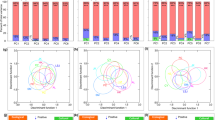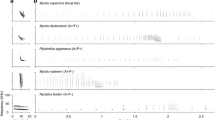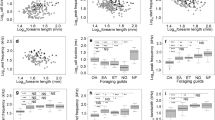Abstract
The geographical variation in animals’ social acoustical signals can reduce recognition across populations and may thus promote assortative mating, reproductive isolation and speciation. However, the social consequences of geographical variation in acoustical signals serving an ecological function are poorly known. Bat echolocation calls are considered to have a dual function; they are used not only for orientation and foraging but also for communication. In this study, we studied the behavioural response of Rhinolophus ferrumequinum to geographical variation in echolocation calls. Using habituation-dishabituation playback experiments, we found that all tested bats from northeast China exhibited obvious responses after switching playback from their own population to those from central east China and southwest China. Using two-choice playback experiments, we showed that the bats from northeast China responded more strongly to echolocation calls from their own population than to those from central east China. Our results demonstrate that Rhinolophus ferrumequinum is able to discriminate between echolocation calls of its local population and a foreign one and that local echolocation calls are preferred over foreign ones in a two-choice context. This study supports the communicative potential of bat echolocation calls and provides insight into the discrimination ability and behavioural preference of bats with respect to geographical variation in echolocation calls.
Significance statement
This study provides behavioural evidence for the communicative role in echolocation calls and indicates that a dual function of echolocation calls exists more commonly in bats. Moreover, this study provides insight into the discrimination ability and preference of bats with respect to frequency variation in echolocation calls and contributes to a better understanding of how geographical evolution in ecological acoustical signals may affect the ability of recognition between populations.




Similar content being viewed by others
References
Andrews MM, Andrews PT, Wills DF, Bevis SM (2006) Ultrasound social calls of greater horseshoe bats (Rhinolophus ferrumequinum) in a hibernaculum. Acta Chiropterol 8:197–212
Baker MC (1982) Vocal dialect recognition and population genetic consequences. Am Zool 22:561–569
Baker MC, Cunningham MA (1985) The biology of bird-song dialects. Behav Brain Sci 8:85–133
Baker MC, Mewaldt LR (1978) Song dialects as barriers to dispersal in white-crowned sparrows, Zonotrichia leucophrys nuttalli. Evolution 32:712–722
Baker MC, Spitler-Nabors KJ, Bradley DC (1982) The response of female mountain white-crowned sparrows to songs from their natal dialect and an alien dialect. Behav Ecol Sociobiol 10:175–179
Balaban E (1988) Cultural and genetic variation in swamp sparrows (Melospiza georgiana): behavioral salience of geographic song variants. Behaviour 105:292–322
Balakrishnan CN, Sorenson MD (2006) Song discrimination suggests premating isolation among sympatric indigobird species and host races. Behav Ecol 17:473–478
Barclay RMR (1982) Interindividual use of echolocation calls: eavesdropping by bats. Behav Ecol Sociobiol 10:271–275
Bastian A, Jacobs DS (2015) Listening carefully: increased perceptual acuity for species discrimination in multispecies signalling assemblages. Anim Behav 101:141–154
Bohn KM, Schmidt-French B, Ma ST, Pollak GD (2008) Syllable acoustics, temporal patterns, and call composition vary with behavioral context in Mexican free-tailed bats. J Acoust Soc Am 124:1838–1848
Boul KE, Funk WC, Darst CR, Cannatella DC, Ryan MJ (2007) Sexual selection drives speciation in an Amazonian frog. Proc R Soc Lond B 274:399–406
Bradley DW, Molles LE, Waas JR (2013) Local–foreign dialect discrimination and responses to mixed-dialect duets in the North Island kōkako. Behav Ecol 24:570–578
Brown ED, Farabaugh SM (1991) Song sharing in a group-living songbird, the Australian magpie, Gymnorhina tibicen part III sex specificity and individual specificity of vocal parts in communal chorus and duet songs. Behaviour 118:244–274
Bruns V, Schmieszek E (1980) Cochlear innervation in the greater horseshoe bat: demonstration of an acoustic fovea. Hear Res 3:27–43
Colbeck GJ, Sillett TS, Webster MS (2010) Asymmetric discrimination of geographical variation in song in a migratory passerine. Anim Behav 80:311–318
Danner JE, Danner RM, Bonier F, Martin PR, Small TW, Moore IT (2011) Female, but not male, tropical sparrows respond more strongly to the local song dialect: implications for population divergence. Am Nat 178:53–63
Dingle C, Poelstra JW, Halfwerk W, Brinkhuizen DM, Slabbekoorn H (2010) Asymmetric response patterns to subspecies-specific song differences in allopatry and parapatry in the gray-breasted wood-wren. Evolution 64:3537–3548
Fenton MB (1974) The role of echolocation in the evolution of bats. Am Nat 108:386–388
Fenton MB (1985) Communication in the Chiroptera. Indiana University Press, Bloomington
Fenton MB (2003) Eavesdropping on the echolocation and social calls of bats. Mammal Rev 33:193–204
Fernandez AA, Fasel N, Knörnschild M, Richner H (2014) When bats are boxing: aggressive behaviour and communication in male Seba’s short-tailed fruit bat. Anim Behav 98:149–156
Flanders J, Jones G, Benda P, Dietz C, Zhang S, Li G, Sharifi M, Rossiter SJ (2009) Phylogeography of the greater horseshoe bat, Rhinolophus ferrumequinum: contrasting results from mitochondrial and microsatellite data. Mol Ecol 18:306–318
Flanders J, Wei L, Rossiter SJ, Zhang S (2011) Identifying the effects of the Pleistocene on the greater horseshoe bat, Rhinolophus ferrumequinum, in East Asia using ecological niche modelling and phylogenetic analyses. J Biogeogr 38:439–452
Gordinho LDO, Matheu E, Hasselquist D, Neto JM (2015) Song divergence between subspecies of reed bunting is more pronounced in singing styles under sexual selection. Anim Behav 107:221–231
Gould E, Negus NC, Novick A (1964) Evidence for echolocation in shrews. J Exp Zool 156:19–37
Gray DA (2005) Does courtship behavior contribute to species-level reproductive isolation in field crickets? Behav Ecol 16:201–206
Griffin DR (1958) Listening in the dark. Yale University Press, New Haven
Grilliot ME, Burnett SC, Mendonça MT (2014) Sex and season differences in the echolocation pulses of big brown bats (Eptesicus fuscus) and their relation to mating activity. Acta Chiropterol 16:379–386
Grilliot ME, Burnett SC, Mendonça MT (2015) Choice experiments demonstrate that male big brown bats (Eptesicus fuscus) prefer echolocation calls of high copulatory females. Acta Chiropterol 17:411–417
Hiryu S, Katsura K, Nagato T, Yamazaki H, Lin LK, Watanabe Y, Riquimaroux H (2006) Intra-individual variation in the vocalized frequency of the Taiwanese leaf-nosed bat, Hipposideros terasensis, influenced by conspecific colony members. J Comp Physiol A 192:807–815
Höbel G (2015) Sexual differences in responses to cross-species call interference in the green treefrog (Hyla cinerea). Behav Ecol Sociobiol 69:695–705
Irwin DE, Bensch S, Price TD (2001) Speciation in a ring. Nature 409:333–337
Jiang T, Wu H, Feng J (2015) The patterns and causes of geographic variation in bat echolocation pulses. Integr Zool 10:241–256
Jones G, Holderied MW (2007) Bat echolocation calls: adaptation and convergent evolution. Proc R Soc Lond B 274:905–912
Jones G, Ransome RD (1993) Echolocation calls of bats are influenced by maternal effects and change over a lifetime. Proc R Soc Lond B 252:125–128
Jones G, Siemers BM (2011) The communicative potential of bat echolocation pulses. J Comp Physiol A 197:447–457
Jones GJ, Sayigh LS (2002) Geographic variation in rates of vocal production of free-ranging bottlenose dolphins. Mar Mammal Sci 18:374–393
Kazial KA, Masters WM (2004) Female big brown bats, Eptesicus fuscus, recognize sex from a caller’s echolocation signals. Anim Behav 67:855–863
Kazial KA, Pacheco S, Zielinski KN (2008) Information content of sonar calls of little brown bats (Myotis lucifugus): potential for communication. J Mammal 89:25–33
Kingston T, Rossiter SJ (2004) Harmonic-hopping in Wallacea’s bats. Nature 429:654–657
Knörnschild M (2014) Vocal production learning in bats. Curr Opin Neurobiol 28:80–85
Knörnschild M, Jung K, Nagy M, Metz M, Kalko E (2012) Bat echolocation calls facilitate social communication. Proc R Soc Lond B 279:4827–4835
Krebs JR, Kroodsma DE (1980) Repertoires and geographical variation in bird song. Adv Study Behav 11:143–177
Lachlan RF, Servedio MR (2004) Song learning accelerates allopatric speciation. Evolution 58:2049–2063
Lameira AR, Delgado RA, Wich SA (2010) Review of geographic variation in terrestrial mammalian acoustic signals: human speech variation in a comparative perspective. J Evol Psychol 8:309–332
Leader N, Geffen E, Mokady O, Yom-Tov Y (2008) Song dialects do not restrict gene flow in an urban population of the orange-tufted sunbird, Nectarinia osea. Behav Ecol Sociobiol 62:1299–1305
Li Y, Wang J, Metzner W, Luo B, Jiang T, Yang S, Shi L, Huang X, Yue X, Feng J (2014) Behavioral responses to echolocation calls from sympatric heterospecific bats: implications for interspecific competition. Behav Ecol Sociobiol 68:657–667
Lin A, Jiang T, Kanwal JS, Lu G, Luo J, Wei X, Luo B, Feng J (2015) Geographical variation in echolocation vocalizations of the Himalayan leaf-nosed bat: contribution of morphological variation and cultural drift. Oikos 124:364–371
Liu Y, Metzner W, Feng J (2013) Vocalization during copulation behavior in greater horseshoe bats, Rhinolophus ferrumequinum. Chin Sci Bull 58:2179–2184
Ma J, Kobayasi K, Zhang S, Metzner W (2006) Vocal communication in adult greater horseshoe bats, Rhinolophus ferrumequinum. J Comp Physiol A 192:535–550
Marler P (2004) Bird calls: their potential for behavioral neurobiology. Ann N Y Acad Sci 1016:31–44
Matsumura S (1979) Mother-infant communication in a horseshoe bat (Rhinolophus ferrumequinum nippon): development of vocalization. J Mammal 60:76–84
McArthur PD (1986) Similarity of playback songs to self song as a determinant of response strength in song sparrows (Melospiza melodia). Anim Behav 34:199–207
Milligan MM, Verner J (1971) Inter-populational song dialect discrimination in the white-crowned sparrow. Condor 73:208–213
Mortega KG, Flinks H, Helm B (2014) Behavioural response of a migratory songbird to geographic variation in song and morphology. Front Zool 11:85
Murphy CG, Gerhardt HC (2000) Mating preference functions of individual female barking treefrogs, Hyla gratiosa, for two properties of male advertisement calls. Evolution 54:660–669
Parsons S, Jones G (2000) Acoustic identification of twelve species of echolocating bat by discriminant function analysis and artificial neural networks. J Exp Biol 203:2641–2656
Podos J (2007) Discrimination of geographical song variants by Darwin’s finches. Anim Behav 73:833–844
Price T (2008) Speciation in birds. Roberts and Company, Greenwood Village
Ptacek MB (2000) The role of mating preferences in shaping interspecific divergence in mating signals in vertebrates. Behav Process 51:111–134
Puechmaille SJ, Borissov IM, Zsebok S, Allegrini B, Hizem M, Kuenzel S, Schuchmann M, Teeling EC, Siemers BM (2014) Female mate choice can drive the evolution of high frequency echolocation in bats: a case study with Rhinolophus mehelyi. PLoS One 9:e103452
Puechmaille SJ, Gouilh MA, Piyapan P, Yokubol M, Mie KM, Bates PJ, Satasook C, Nwe T, Bu SSH, Mackie IJ (2011) The evolution of sensory divergence in the context of limited gene flow in the bumblebee bat. Nat Commun 2:573
Racey PA (2009) Reproductive assessment of bats. In: Kunz TH, Parsons S (eds) Ecological and behavioral methods for the study of bats. The John Hopkins University Press, Baltimore, pp. 249–264
Rothstein SI, Fleischer RC (1987) Vocal dialects and their possible relation to honest status signalling in the brown-headed cowbird. Condor 89:1–23
Ruczyński I, Kalko EKV, Siemers BM (2007) The sensory basis of roost finding in a forest bat, Nyctalus noctula. J Exp Biol 210:3607–3615
Ruczyński I, Kalko EKV, Siemers BM (2009) Calls in the forest: a comparative approach to how bats find tree cavities. Ethology 115:167–177
Schevill W (1956) Evidence for echolocation by cetaceans. Deep Sea Res Pt II 3:153–154
Schnitzler HU, Moss CF, Denzinger A (2003) From spatial orientation to food acquisition in echolocating bats. Trends Ecol Evol 18:386–394
Schuchmann M, Siemers BM (2010) Behavioral evidence for community-wide species discrimination from echolocation calls in bats. Am Nat 176:72–82
Schuchmann M, Puechmaille SJ, Siemers BM (2012) Horseshoe bats recognise the sex of conspecifics from their echolocation calls. Acta Chiropterol 14:161–166
Schuller G, Pollak G (1979) Disproportionate frequency representation in the inferior colliculus of doppler-compensating greater horseshoe bats: evidence for an acoustic fovea. J Comp Physiol A 132:47–54
Searcy W, Nowicki S, Hughes M, Peters S (2002) Geographic song discrimination in relation to dispersal distances in song sparrows. Am Nat 159:221–230
Slabbekoorn H, Smith TB (2002) Bird song, ecology and speciation. Philos Trans R Soc B 357:493–503
Suga N, Jen PH (1976) Disproportionate tonotopic representation for processing CF-FM sonar signals in the mustache bat auditory cortex. Science 194:542–544
Sun K, Luo L, Kimball RT, Wei X, Jin L, Jiang T, Li G, Feng J (2013) Geographic variation in the acoustic traits of greater horseshoe bats: testing the importance of drift and ecological selection in evolutionary processes. PLoS One 8:e70368
Uy JAC, Moyle RG, Filardi CE (2009) Plumage and song differences mediate species recognition between incipient flycatcher species of the Solomon Islands. Evolution 63:153–164
Velásquez NA (2014) Geographic variation in acoustic communication in anurans and its neuroethological implications. J Phys Paris 108:167–173
Voigt-Heucke SL, Taborsky M, Dechmann DKN (2010) A dual function of echolocation: bats use echolocation calls to identify familiar and unfamiliar individuals. Anim Behav 80:59–67
Wilkins MR, Seddon N, Safran RJ (2013) Evolutionary divergence in acoustic signals: causes and consequences. Trends Ecol Evol 28:156–166
Wright TF, Rodriguez AM, Fleischer RC (2005) Vocal dialects, sex-biased dispersal, and microsatellite population structure in the parrot Amazona auropalliata. Mol Ecol 14:1197–1205
Yovel Y, Melcon ML, Franz MO, Denzinger A, Schnitzler HU (2009) The voice of bats: how greater mouse-eared bats recognize individuals based on their echolocation calls. PLoS Comput Biol 5:e1000400
Zuk M, Rotenberry JT, Simmons LW (2001) Geographical variation in calling song of the field cricket Teleogryllus oceanicus: the importance of spatial scale. J Evol Biol 14:731–741
Acknowledgments
We thank the two anonymous reviewers for their helpful suggestions on the previous version of the manuscript. This work was supported by the National Natural Science Foundation of China (grant nos. 31500314 and 31500307) and China Postdoctoral Science Foundation (grant no. 2015M581384).
Author information
Authors and Affiliations
Corresponding author
Ethics declarations
Conflict of interest
The authors declare that they have no competing interests.
Ethical approval
Bat capture and playback experiments in this study were approved by the National Animal Research Authority in Northeast Normal University, China. Our work did not cause any effects on bat mortality. We maintained the bats carefully and released them at the site of capture when all trials were completed.
Additional information
Communicated by C. Voigt
Rights and permissions
About this article
Cite this article
Lin, A., Liu, H., Chang, Y. et al. Behavioural response of the greater horseshoe bat to geographical variation in echolocation calls. Behav Ecol Sociobiol 70, 1765–1776 (2016). https://doi.org/10.1007/s00265-016-2182-3
Received:
Revised:
Accepted:
Published:
Issue Date:
DOI: https://doi.org/10.1007/s00265-016-2182-3




